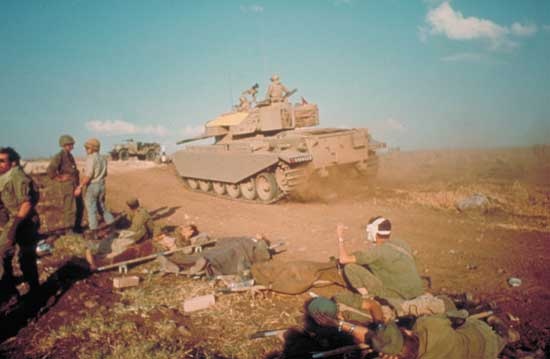Yom Kippur War
Middle East 【1973】
also called the October War, the Ramadan War, or the Fourth Arab-Israeli War
 damaging, inconclusive war and the fourth of the Arab-Israeli wars. The war was initiated by Egypt and Syria on Oct. 6, 1973, on the Jewish holy day of Yom Kippur and during Ramadan (Ramaḍān), the month of fasting in Islam (Islām), and continued until Oct. 26, 1973. The war, which eventually drew both the United States and the Soviet Union (Union of Soviet Socialist Republics) into indirect confrontation in defense of their respective allies, was launched with the diplomatic aim of convincing a chastened—if still undefeated— Israel to negotiate on terms more favourable to the Arab countries.
damaging, inconclusive war and the fourth of the Arab-Israeli wars. The war was initiated by Egypt and Syria on Oct. 6, 1973, on the Jewish holy day of Yom Kippur and during Ramadan (Ramaḍān), the month of fasting in Islam (Islām), and continued until Oct. 26, 1973. The war, which eventually drew both the United States and the Soviet Union (Union of Soviet Socialist Republics) into indirect confrontation in defense of their respective allies, was launched with the diplomatic aim of convincing a chastened—if still undefeated— Israel to negotiate on terms more favourable to the Arab countries.The previous Arab-Israeli war, the Six-Day War (1967), was followed by years of sporadic fighting, which developed into a full-scale war in 1973. On the afternoon of October 6, Israel was attacked simultaneously on two fronts by Egypt and Syria. With the element of surprise to their advantage, Egyptian forces successfully crossed the Suez Canal with greater ease than expected, suffering only a fraction of the anticipated casualties, while Syrian forces were able to launch their offensive against Israeli positions and break through to the Golan Heights. The intensity of the Egyptian and Syrian assault, so unlike the situation in 1967, rapidly began to exhaust Israel's reserve stocks of munitions. Israeli Prime Minister Golda Meir (Meir, Golda) turned to the United States for aid, while the Israeli general staff hastily improvised a battle strategy. The reluctance of the United States to help Israel changed rapidly when the Soviet Union commenced its own resupply effort to Egypt and Syria. U.S. Pres. Richard Nixon (Nixon, Richard M.) countered by establishing an emergency supply line to Israel, even though the Arab countries imposed a costly oil embargo and various U.S. allies refused to facilitate the arms shipments.
With reinforcements on the way, the Israel Defense Forces (see Israel: The armed forces (Israel)) rapidly turned the tide. Israel succeeded in disabling portions of the Egyptian air defenses, which allowed Israeli forces commanded by Gen. Ariel Sharon (Sharon, Ariel) to cross the Suez Canal and surround the Egyptian Third Army. On the Golan front, Israeli troops, at heavy cost, repulsed the Syrians and advanced to the edge of the Golan plateau on the road to Damascus. On October 22 the United Nations Security Council (Security Council, United Nations) adopted resolution 338, which called for an immediate end to the fighting; despite this, however, hostilities continued for several days thereafter and finally ceased on October 26.
Israel and Egypt signed a cease-fire agreement in November and peace agreements on Jan. 18, 1974. The accords provided for Israeli withdrawal into the Sinai (Sinai Peninsula) west of the Mitla and Gidi passes, while Egypt was to reduce the size of its forces on the east bank of the canal. A United Nations (UN) peacekeeping force established a buffer zone between the two armies. This agreement was supplemented by another, signed on Sept. 4, 1975. On May 31, 1974, Israel and Syria signed a cease-fire agreement that also covered separation of their forces by a UN buffer zone and exchange of prisoners of war. In June the oil embargo was lifted.
With significant casualties and large quantities of military equipment disabled or destroyed, the war proved costly for Israel, Egypt, and Syria. Nevertheless, although Egypt did not win the war in any military sense, its initial successes in October 1973 enabled President Anwar el-Sādāt (Sādāt, Anwar el-) to pronounce the war an Egyptian victory and to seek an honourable peace.
- Table 2 World Cereal Supply and Distribution
- Table 2 World Cocoa Bean Production
- Table 2 World Cotton Production and Consumption
- Table 2 World Green Coffee Production
- Table 2 World Production of Centrifugal Sugar
- Table 2 World Production of Major Oilseeds and Products
- Table 2 World Production of Milk
- Table 3 Consumer Prices in OECD Countries
- Table 3 Real Gross Domestic Products of Selected OECD Countries
- Table 3 Selected Indexes of World Agricultural and Food Production
- Table 3 Shipment of Food Aid in Cereals
- Table 3 Standardized Unemployment Rates in Selected Developed Countries
- Table 3 World Cereal Supply and Distribution
- Table 3 World Cocoa Bean Production
- Table 3 World Cotton Production and Consumption
- Table 3 World Green Coffee Production
- Table 3 World Production of Centrifugal Sugar
- Table 3 World Production of Major Oilseeds and Products
- Table 4 Consumer Prices in OECD Countries
- Table 4 Selected Indexes of World Agricultural and Food Production
- Table 4 Shipment of Food Aid in Cereals
- Table 4 Standardized Unemployment Rates in Selected Developed Countries
- Table 4 World Cereal Supply and Distribution
- Table 4 World Cocoa Bean Production
- Table 4 World Green Coffee Production